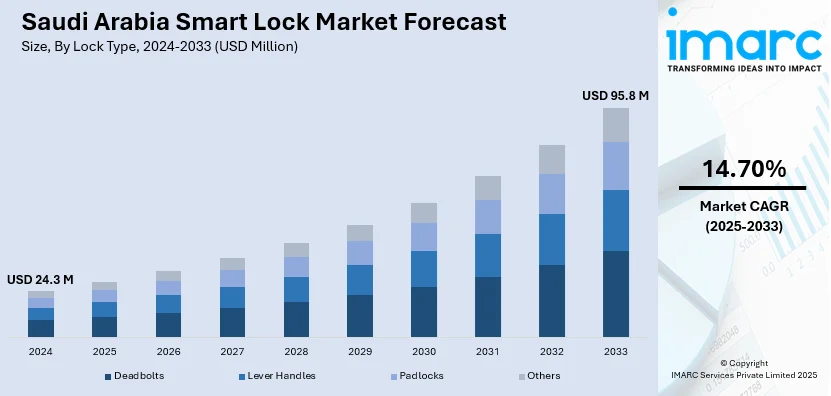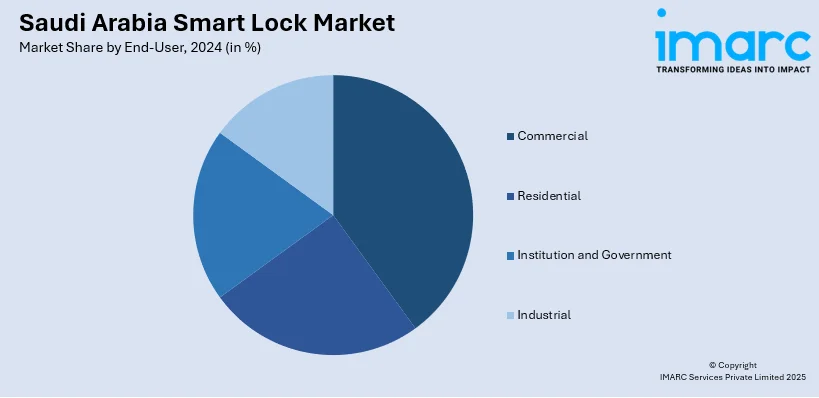
Saudi Arabia Smart Lock Market Size, Share, Trends and Forecast by Lock Type, Communication Protocol, End-User, and Region, 2025-2033
Saudi Arabia Smart Lock Market Overview:
The Saudi Arabia smart lock market size reached USD 24.3 Million in 2024. Looking forward, IMARC Group expects the market to reach USD 95.8 Million by 2033, exhibiting a growth rate (CAGR) of 14.70% during 2025-2033. The market is experiencing strong growth, driven by rising smart home adoption, increasing security concerns, and urban development. Moreover, technological advancements and strategic partnerships are further enhancing market expansion across residential, commercial, and institutional sectors.
|
Report Attribute
|
Key Statistics
|
|---|---|
|
Base Year
|
2024 |
|
Forecast Years
|
2025-2033
|
|
Historical Years
|
2019-2024
|
| Market Size in 2024 | USD 24.3 Million |
| Market Forecast in 2033 | USD 95.8 Million |
| Market Growth Rate 2025-2033 | 14.70% |
Saudi Arabia Smart Lock Market Trends:
Increasing Smart Home Penetration
Increasing penetration of smart homes in Saudi Arabia is playing a major role in fueling the demand for smart locks. With residential properties in urban regions increasingly adopting high-end home automation systems, there is an increasing demand for smart access control systems. This trend has significantly influenced the Saudi Arabia smart lock market share, especially in high-income communities where consumers prioritize convenience, security, and digital control. Smart locks are also becoming an integral component of modern residential ecosystems, used in conjunction with other smart devices such as security cameras, lighting, and alarm systems. Remote locking and unlocking using smartphones or voice commands increase their appeal among technology-oriented consumers. Supporting this momentum, several global players are actively expanding in the region to capitalize on the rising demand. Increasing focus on security and the demand for safe access control across multi-family residences, villas, and gated communities also fuels adoption. These are the elements that combined are fueling the market growth and represent a promising segment of the home automation market.

Integration with IoT Devices
Smart locks are increasingly being used in combination with other IoT-enabled devices, offering seamless control over home environments. These locks can interact with systems such as security cameras, smart lighting, doorbells, and voice assistants, allowing users to manage access, monitor activity, and automate functions through a unified platform. This integration not only enhances convenience and user experience but also strengthens overall home security. As consumers in Saudi Arabia become more tech-savvy and demand interconnected living spaces, the appeal of IoT-enabled smart locks continues to grow. This trend is further supported by rising investments in smart infrastructure and connected technologies, contributing significantly to Saudi Arabia smart lock market growth.
Rising Security Awareness
Growing security awareness in Saudi Arabia is compelling homeowners as well as organizations to seek smarter, more secure security solutions. With the increasing fear of burglary, unauthorized entry, and safeguarding assets, consumers are now choosing advanced locking systems with real-time monitoring, mobile alerts, and remote management. Smart locks not only improve security but also provide convenience as they allow users to monitor and control access remotely. These devices are most in demand in cities and high-end residential areas where demand for technology-enhanced security is increasing. With more people becoming aware of cyber security smart locks are increasingly becoming a part of home automation systems. This heightened focus on security is playing a significant role in shaping the Saudi Arabia smart lock market outlook, driving innovation and long-term adoption across sectors.
Saudi Arabia Smart Lock Market Segmentation:
IMARC Group provides an analysis of the key trends in each segment of the market, along with forecasts at the regional level for 2025-2033. Our report has categorized the market based on lock type, communication protocol, and end-user.
Lock Type Insights:
- Deadbolts
- Lever Handles
- Padlocks
- Others
The report has provided a detailed breakup and analysis of the market based on the lock type. This includes deadbolts, lever handles, padlocks, and others.
Communication Protocol Insights:
- Bluetooth
- Wi-Fi
- Others
A detailed breakup and analysis of the market based on the communication protocol have also been provided in the report. This includes Bluetooth, Wi-Fi, and others.
End-User Insights:

- Commercial
- Residential
- Institution and Government
- Industrial
A detailed breakup and analysis of the market based on the end user have also been provided in the report. This includes commercial, residential, institution and government, and industrial.
Regional Insights:
- Northern and Central Region
- Western Region
- Eastern Region
- Southern Region
The report has also provided a comprehensive analysis of all the major regional markets, which include Northern and Central Region, Western Region, Eastern Region, and Southern Region.
Competitive Landscape:
The market research report has also provided a comprehensive analysis of the competitive landscape. Competitive analysis such as market structure, key player positioning, top winning strategies, competitive dashboard, and company evaluation quadrant has been covered in the report. Also, detailed profiles of all major companies have been provided.
Saudi Arabia Smart Lock Market Report Coverage:
| Report Features | Details |
|---|---|
| Base Year of the Analysis | 2024 |
| Historical Period | 2019-2024 |
| Forecast Period | 2025-2033 |
| Units | Million USD |
| Scope of the Report |
Exploration of Historical Trends and Market Outlook, Industry Catalysts and Challenges, Segment-Wise Historical and Future Market Assessment:
|
| Lock Types Covered | Deadbolts, Lever Handles, Padlocks, Others |
| Communication Protocols Covered | Bluetooth, Wi-Fi, Others |
| End-Users Covered | Commercial, Residential, Institution and Government, Industrial |
| Regions Covered | Northern and Central Region, Western Region, Eastern Region, Southern Region |
| Customization Scope | 10% Free Customization |
| Post-Sale Analyst Support | 10-12 Weeks |
| Delivery Format | PDF and Excel through Email (We can also provide the editable version of the report in PPT/Word format on special request) |
Key Questions Answered in This Report:
- How has the Saudi Arabia smart lock market performed so far and how will it perform in the coming years?
- What is the breakup of the Saudi Arabia smart lock market on the basis of lock type?
- What is the breakup of the Saudi Arabia smart lock market on the basis of communication protocol?
- What is the breakup of the Saudi Arabia smart lock market on the basis of end-user?
- What is the breakup of the Saudi Arabia smart lock market on the basis of region?
- What are the various stages in the value chain of the Saudi Arabia smart lock market?
- What are the key driving factors and challenges in the Saudi Arabia smart lock market?
- What is the structure of the Saudi Arabia smart lock market and who are the key players?
- What is the degree of competition in the Saudi Arabia smart lock market?
Key Benefits for Stakeholders:
- IMARC’s industry report offers a comprehensive quantitative analysis of various market segments, historical and current market trends, market forecasts, and dynamics of the Saudi Arabia smart lock market from 2019-2033.
- The research report provides the latest information on the market drivers, challenges, and opportunities in the Saudi Arabia smart lock market.
- Porter's five forces analysis assist stakeholders in assessing the impact of new entrants, competitive rivalry, supplier power, buyer power, and the threat of substitution. It helps stakeholders to analyze the level of competition within the Saudi Arabia smart lock industry and its attractiveness.
- Competitive landscape allows stakeholders to understand their competitive environment and provides an insight into the current positions of key players in the market.
Need more help?
- Speak to our experienced analysts for insights on the current market scenarios.
- Include additional segments and countries to customize the report as per your requirement.
- Gain an unparalleled competitive advantage in your domain by understanding how to utilize the report and positively impacting your operations and revenue.
- For further assistance, please connect with our analysts.
 Request Customization
Request Customization
 Speak to an Analyst
Speak to an Analyst
 Request Brochure
Request Brochure
 Inquire Before Buying
Inquire Before Buying




.webp)




.webp)












